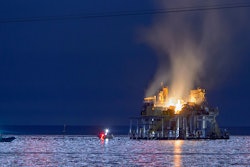
Every year, the United States gulf coast is at risk for hurricanes from June until November. Residents and companies alike need to be prepared. The oil refining industry is especially at risk. Approximately 25 percent of the refining capacity in the United States is located along the gulf coast (ET). In the wake of damages caused by Hurricane Katrina, Gustav and more recently Hurricane Harvey and Hurricane Nate, refineries need to evaluate hurricane preparedness plans to ensure the public is kept safe.
Historical Pollution From Hurricanes
In 2005, Hurricane Katrina caused at least 44 oil spills resulting in millions of gallons of oil pollution throughout the gulf coast region. Due to the high levels of devastation, the Coast Guard and other agencies focused on tending to the more immediate needs of rescuing residents and transporting them to safety. It took three weeks before they were able to assess the extent of contamination.
Following Hurricane Harvey, two Exxon Mobile refineries were damaged, one of which is the second largest refinery in the nation. As a result, volatile organic compounds, a pollutant known as VOCs, were released into the air. The day after Hurricane Nate, over 90 percent of the refineries in the gulf coast region were out of production for at least one day.
Refineries typically exceed their air pollution emissions allowances when they shut down quickly during a hurricane or other types of emergency situations. Residents living near these facilities face the possibility of increased respiratory irritation or asthma attacks directly resulting from the air pollutants. Facilities damaged during a storm can also contaminate local water supplies when rainwater carries chemicals downstream.
Hurricane Damage Prevention Methods
To prepare for future hurricanes, refineries should continue to invest in hurricane-resistant infrastructure. Plants located in flood-prone areas would benefit from stairwells, walkways and grating made of fiberglass reinforced plastic, which is corrosion-resistant and non-conductive. Inland facilities that use FRP can reduce damages resulting from flooding. Post-storm, employees can quickly access facilities to administer repairs, preventing the public from any sustained pollution.
Specialty corrosion and impact resistant coatings are available for use in refineries. Although offshore facilities always need to be equipped for rough conditions, inland facilities in hurricane zones may want to invest in coatings to prevent damages to terminal storage in floodable areas. Coatings need to be regularly inspected to verify storm damage hasn't compromised them. Timely repairs minimize the level of pollution residents get exposed to.
Heavy-duty adhesives, sealants and coatings aid in the repair of damaged pipelines and storage tanks encountered during routine inspections. Employees using proper protective equipment can easily prevent future leaks or administer repairs after a weather event. Sealing pipelines and tanks prevents potential water contamination from spills and leaks.
Additionally, refineries should perform routine assessments on the state of infrastructure before hurricane season. This way, there will be time to make any necessary repairs before storms hit. Facilities in need of more help or guidance can hire structural consultants to provide hurricane preparedness evaluations and recommendations. The public benefits when refineries take every possible precaution to reduce pollution and ensure safety.
Current Preparation Methods
Safety protocol is in place to protect refinery employees during emergency events. Several days before a storm hits the majority of workers must evacuate the refinery. Any remaining employees begin to shut down facilities to minimize damage and pollution release. Offshore platforms are also secured and evacuated during storm events for employee safety. After a storm has passed, refineries use drones or other aerial devices to assess conditions and damages. No repair work can begin until conditions are safe.
Refineries have taken steps over the years to minimize hurricane damage. Facilities have raised walkways and other elevated structures and strengthened external infrastructure. Additionally, refineries have stored emergency supplies, trained employees, obtained backup power sources and collaborated with local and state government agencies.
Though these procedures ensure the safety of employees and minimize damages to facilities, they could be improved to include protection measures for the general public from air and water pollution resulting from accidental releases. Refineries should revise hurricane preparedness plans to ready their facilities for hurricane season with a greater focus on reducing pollution and improving public safety.
Megan Ray Nichols is a freelance science writer.






















